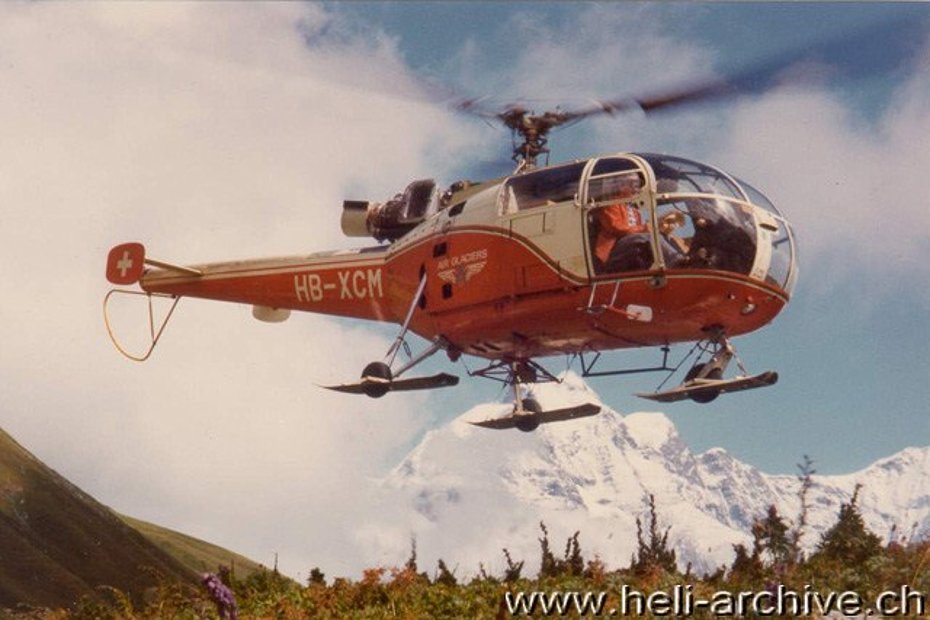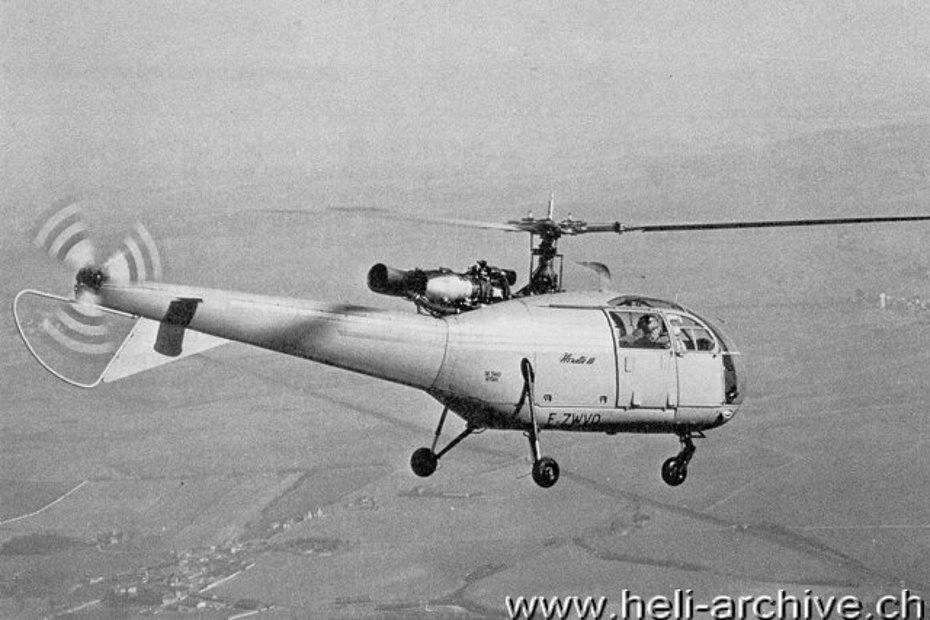
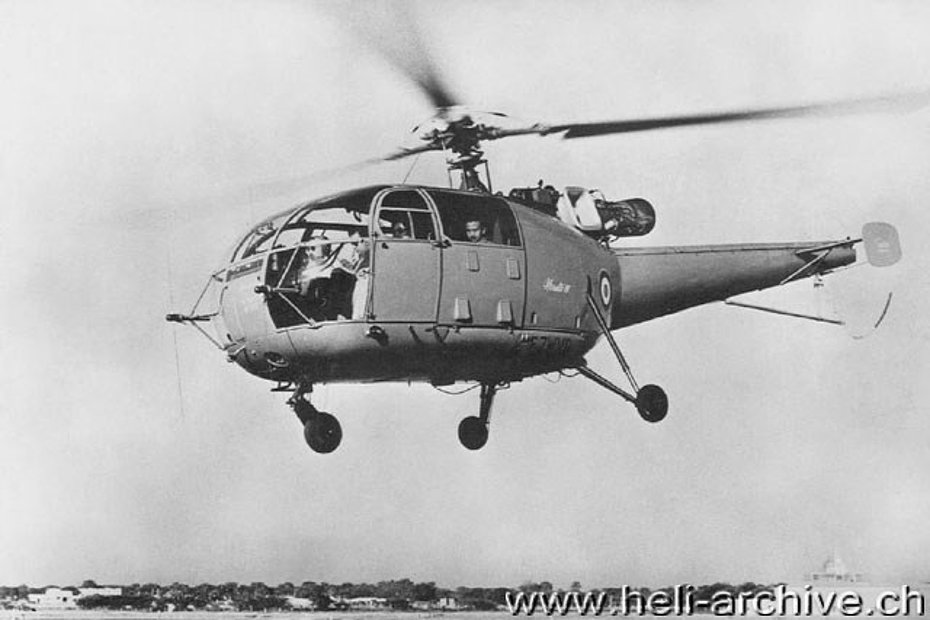
SE 3160 Alouette III - History and technical description
Some historical notes
Between 1957-1958 the French engineer Charles Marchetti, who was at the head of the group who developed the Alouette II, along with his technicians worked on a new project to develop a larger, wider and more powerful helicopter. He then proposed to the newly founded Sud Aviation his idea and after obtaining formal approval and the necessary credits, the group immediately commenced to build two prototypes. The new helicopter was christened Alouette III (the French equivalent of Lark).
With valuable experience gained on the predecessors (among them also the Alouette II F-WIEA Gouverneur, a special version – never produced in series – designed for VIP duties and fully enclosed, and the SE 3150 with a larger rotor and a more powerful turbine which then inspired the realisation of the SA 315B Lama) the group completed the first prototype by the beginning of 1959.
Compared to its predecessor the Alouette III had a roomier cabin accommodating up to six passengers along with the pilot or two litter patients and one/two medical assistants, a more powerful Artouste III turbine, larger diameter main and tail rotor, new transmission, fully enclosed fuselage fitted with tricycle landing gear, and larger payload.
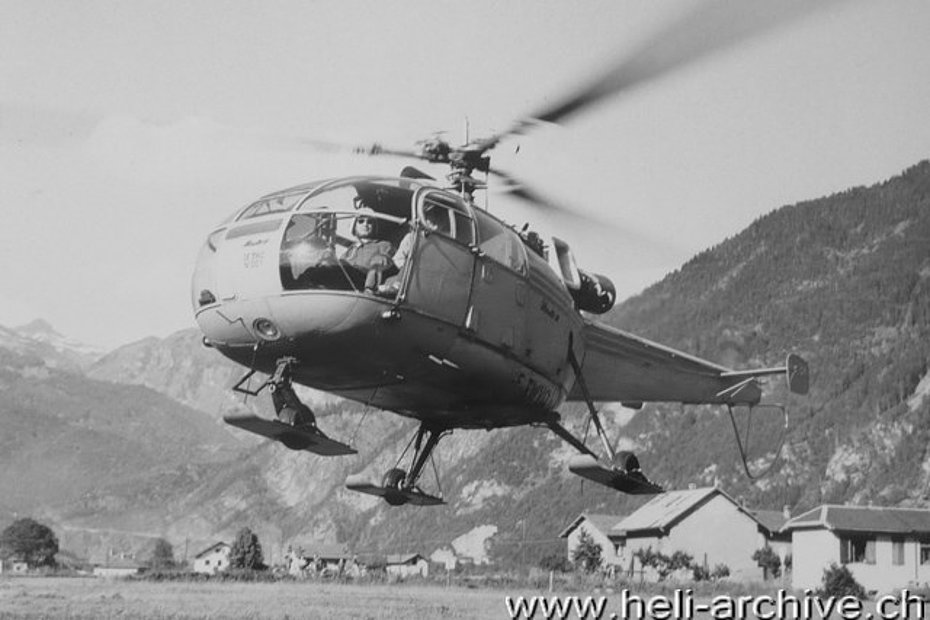
The first prototype registered F-ZWVQ made its first test flight in Paris-Le Bourget on the 28th of February 1959 with the aircrew composed of the famous test-pilot Jean Boulet (who passed away on the 13th of February 2011 at the age of 90 years) and the flight engineer Robert Malus.
The second prototype registered F-ZWVR made its first test flight in May piloted by Roland Coffignot.
The following month the Alouette III did its first official apparition during the International Air Show organised in Paris-Le Bourget from the 12th until the 21st of June.
At that time however the helicopter did not yet had its final configuration: the horizontal stabilizer for example was a bit different, the vertical stabilizer was later removed, frontal doors were only partially glazed, etc.
A long series of test flights using both prototypes was started with the aim of obtaining certification. Meantime the French Army was the first to show a concrete interest in the new aircraft. That same year it ordered three pre-series units which were then delivered during 1960.
On the 22nd of June 1960, Jean Boulet at the controls of the first prototype, to show the remarkable altitude performances of the helicopter, did a memorable landing on the top of the Mont Blanc (4’810 meters) with four passengers and 150 kg of equipment on board.
In October-November Boulet did a series of flight demonstration along the Himalaya chain for the Indian Air Force which was seriously interested to purchase the Alouette III.
On the 6th of November in the region of Kullu-Manali Boulet landed (and took-off!) with one passenger and 250 kg of equipment and fuel from the Mount Deo Tibba at an altitude of 6’004 meters.
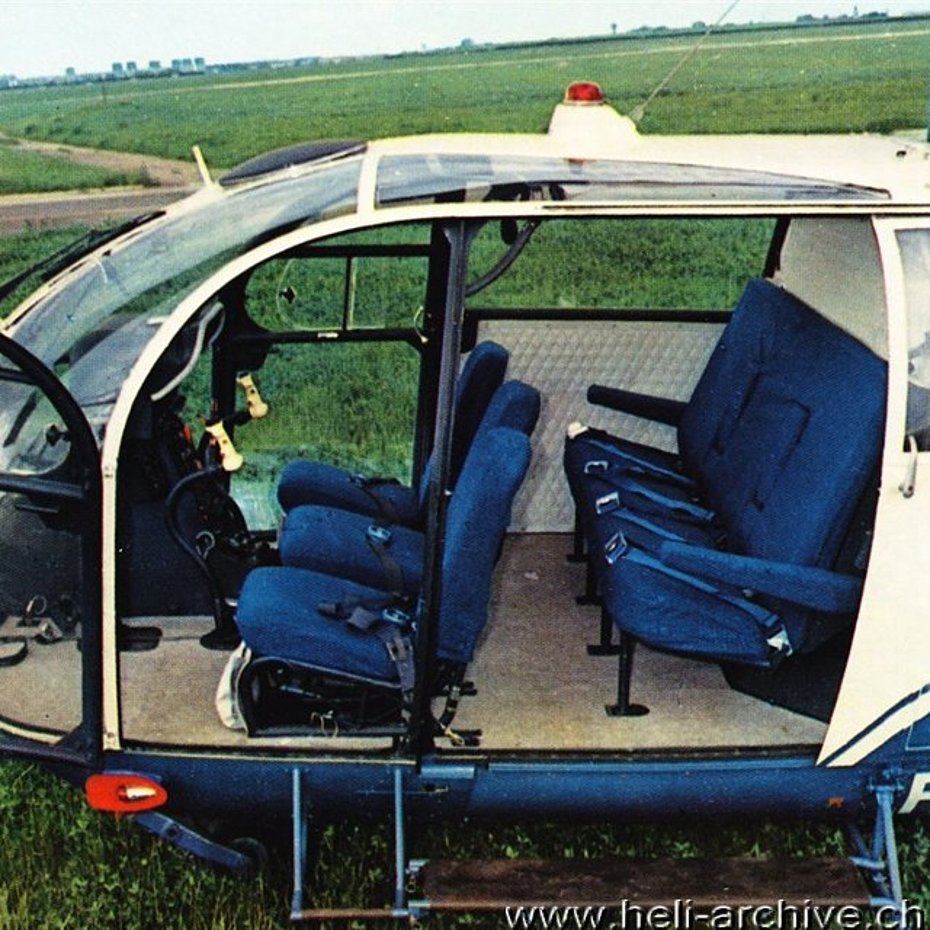
This remarkable record, which was widely advertised by the French manufacturer, then evidently contributed to boost helicopter sales.
Series production started in 1961. The first to leave the assembly line (production n° 1001) was delivered on the 25th July 1961 to the Burmese Air Force.
On the 15th of December 1961 the French Civil Authority accorded Sud Aviation the civil airworthiness certificate (French type certificate n° 14).
The production of this model (and its succeeding variants introduced much later), which was commercialized all over the world, continued until 1985.
Sud Aviation, later becoming Aérospatiale in 1970, produced altogether 1’437 aircraft with several others produced under license in India (250 by the Hindustan Aeronautics Limited - HAL), Romania (180 by the Intreprinderea de constructji aeronautice – IAR) and in Switzerland (60 by Eidgenössische Flugzeugwerke for the Swiss Army).
The Alouette III’s exceptionally long and successful career in various military and emergency rescue capacities is a tribute to the talent and dedication of Sud Aviation’s research team.
Technical description
The SE 3160 Alouette III manufactured by Sud Aviation is a light multi-role helicopter of standard configuration.
It was inspired by his predecessor, the Alouette II produced in large series for military and civil customers.
Designed to carry seven occupants in its passenger version, the Alouette III is fully faired in with the exception of the turboshaft. It is normally fitted with a tricycle landing gear. However float gears or skis can be easily installed to permit landing of the craft on water or snow.
The aircraft incorporates hydraulic servo-controls (collective and cyclic), high sensitivity constant speed governor, automatic starting system, computer and collective pitch indicator, enabling the pilot to establish instantly max. take off weight and in hovering flight aircraft weight from prevailing altitude and outside air temperature conditions.
The airframe comprises a body structure with a cabin at the front and a tail boom at the rear.
The spacious cabin offers space for a pilot and up to six passengers. Up front there are three adjustable seats with extendable harnesses. The pilot's seat is located on the right side, while the two passengers seat are on his left side. At the rear there are two folding and removable two-place seats (four places) with safety belts.
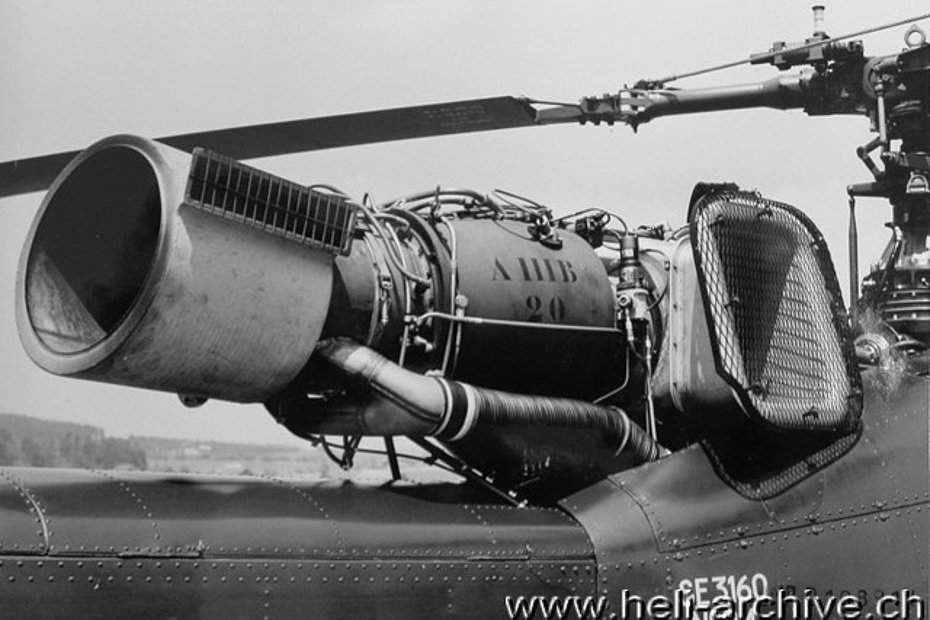
The console which supports the instrument panel is located slightly to the right of the aircraft center line.
The front portion of the cabin is enclosed with large Plexiglas panels, so that the visual is excellent in all directions. There are four doors: the two front doors fully glazed are jettisonable in flight in case of emergency. The two sliding rear doors are glazed in the upper portion.
When used as a military aerial ambulance the helicopter is fitted with an equipment of simple design, easy to install, permitting the transportation of two stretcher patients, one seated casualty and a doctor. To facilitate the load the patient stretcher the rear doors can also be hinged upward.
In civil service however the helicopter is normally used to transport a single patient stretcher who can be medically assisted in flight.
For search and rescue operations in mountain country or at sea the helicopter can be fitted with an air-operated hoist fitted to the left hand side of the cabin. Three people can be successively hoisted into the cabin. The left rear portion of the cabin floor hinges downward to permit operation of the rescue hoist.
The center structure is made essentially of welded steel tubes covered with detachable fairings, and a transmission support platform commonly called plancher mécanique. The structure encloses a 565 litres capacity fuel tank (kerosene Jet-A1), the support with the battery and other equipments. The fuel tank is isolated from the power unit by firewalls. On both sides there is a baggage compartment.
Lateral step-ladders facilitate access to the main rotor head.
The tail boom of semi-monocoque construction carries the tail drive shaft, the anti-torque rotor with its protection arc and the horizontal stabilizer.
The fully articulated main rotor carries three metal rotor blades. The blades consist of a light alloy extruded leading edge spar to which is bonded a light alloy sheet metal skin filled with lightweight filler material and fitted with stainless steel leading edge coverings. The main rotor blades are of parallel plan form with a built-in-twist.
The main rotor transmission system consists of a three-stage main gear box driven trough a centrifugal clutch and a main drive shaft and tail gear box.
The tail rotor blades consist of two bonded light alloy metal sheets with stainless steel leading edge protection. They are individually articulated relative to the hub, in the flapping pane, and are connected to a collective pitch control system. The tail rotor rotates clockwise when viewed from behind.
Overhaul interval of the airframe is 3'200 hours (at the beginning the overhaul was necessary each 1'200 hours of flight).
The turboshaft Artouste IIIB
The SE 3160 Alouette III is powered by an Artouste IIIB manufactured by Turboméca, a French company founded in 1938 by Joseph Szydlowski. This turboshaft (frequently misused turbine) has been certified by the French Official Services on the 25th of May 1961.
The Artouste IIIB is a single-spool turboshaft engine with a constant rotational speed, derived from the Artouste IIC which powered the SE 3130 Alouette II. It differs from the latter mainly because it has an additional compressor stage and turbine which give it better performance and a greater power.
This engine develops a max take-off thermal power of 640/870 kW/hp. The maximum available power of 420/570 kW/hp, as limited by reduction gearing, is maintained up to 4’000-4’500 meters in ISA conditions. The maximum continuous shaft power is 405/450 kW/hp.
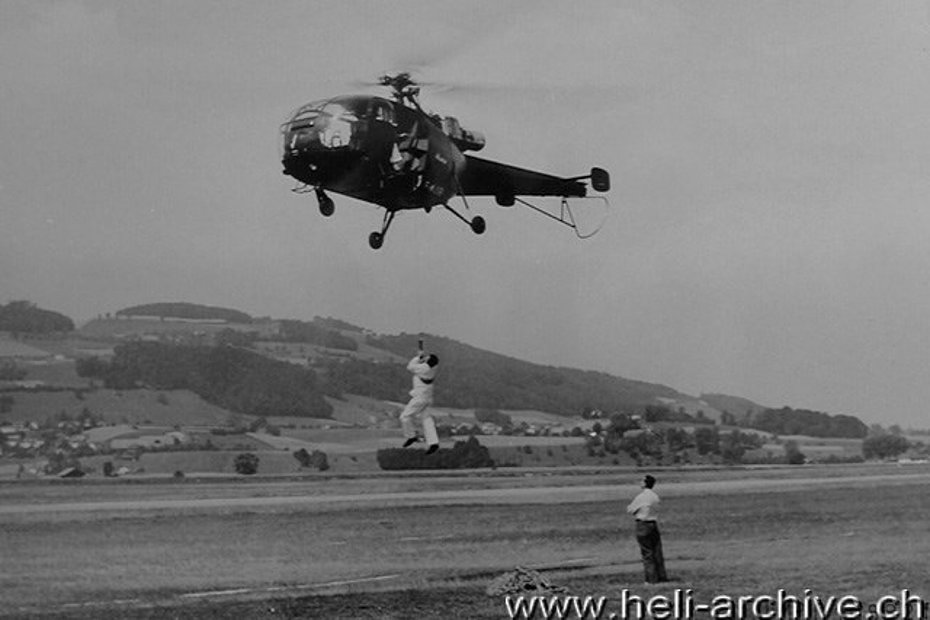
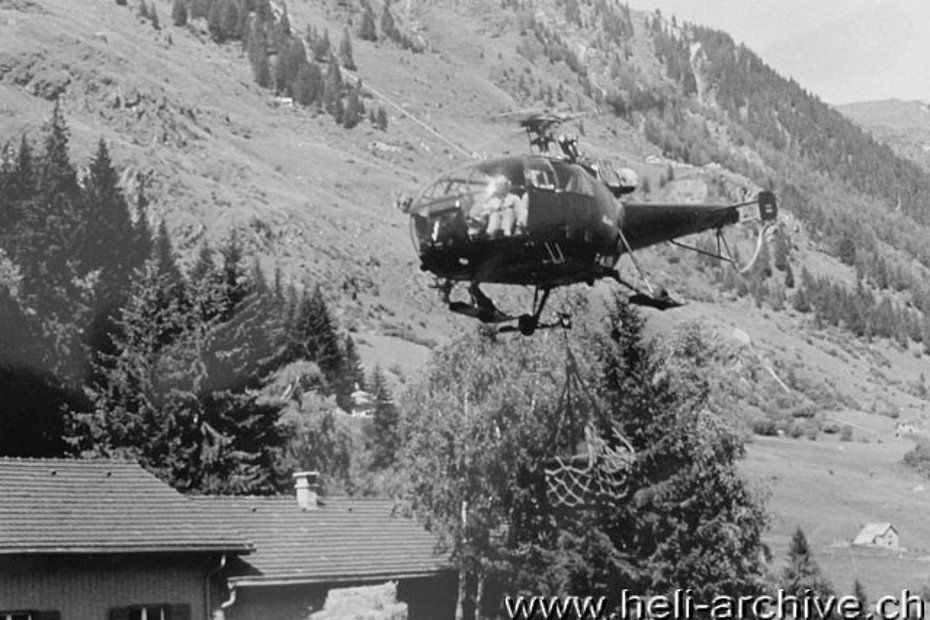
The turboshaft is equipped with a speed governor which maintains during the flight a constant rotational speed of 33’500 rpm.
The Artouste IIIB, with its characteristic prolonged sound roaring, includes: a single-stage axial compressor, a single-stage centrifugal compressor, a direct flow annular combustion chamber with centrifugal fuel injection, a three-stage axial turbine, an exhaust diffuser, the main power offtake, the drive gears of the various accessories (fuel pump, speed governor, oil pump, starter generator, tachometer, generator).
The axial compressor and the three-stage axial turbine are mounted on the same axis. This grant an immediate response to each input from the pilot, a characteristic particularly appreciated.
The maximum permissible temperatures (temperature outlet turbine or TOT) are the following: take-off (5 min) 550°C, continuous 500°c. The turbine exhaust gas temperature is measured by two thermocouples.
The turboshaft has a weight of 182 kg and is attached to the fuselage trough three points, allowing for easy replacement.
Overhaul interval of the turboshaft is 3'000 hours or 15 years (at the beginning the overhaul was necessary each 1'750 hours of flight).
Performances
In standard atmospheric conditions, at its maximum take-off weight of 2’100 kg, the helicopter has a cruising speed of 150-180 km/h, while the never exceed speed at sea level is 210 km/h. Its absolute service ceiling is 6'500 meters.
At its MTOW the helicopter hovers in ground effect at about 4’250 meters, or 2'000 meters out of ground effect. The initial rate of climb is about 330 m/min.
With an average hourly fuel consumption of 200 liters, its range is about 500 km, corresponding to 2h45min of flight endurance.
Dimensions, weights and payload
The main rotor of the SE 3160 Alouette III has a diameter of 11.02 m (disc rotor area 95 m2), while its tail rotor has a diameter of 1.91 m (rotor disc area 2.87 m2. The fuselage has a length of 10.14 m. The height measured on the top of the rotor mast is 2.97 m.
The aircraft standard empty weight is about 1'105 kg, while its MTOW is 2’100 kg.
Allowing for a standard pilot weight (77 kg) and with a fuel and oil reserve for one hour of flight (about 184 kg) the helicopter could carry six passengers with their baggage. On its barycentric hook it could carry up to 750 kg.
Rotor limitations
In flight the main rotor rotates at a constant speed of 353 rpm, while the tail rotor rotates at 2001 rpm. In autorotation the main rotor rpm must be kept among 270 and 420 rpm.
Optional equipment
The versatility of the SE 3160 Alouette III can be further extended using the following main optional equipment: dual controls, rotor brake, heather, casualty carrying equipment, rescue hoist, cargo sling, skis, float landing gear, emergency flotation gear, external cargo carriers, cabin arrangement for rescue at sea, VIP interiors, landing light.
Civil employ
The 3160 Alouette III has found a wide employ among the civil defense, police, firemen corps and obviously a large number of aerial companies.
Its multi-role character makes it suited for the transportation of passengers and merchandise, firefighting operations, but it is especially in the search and rescue role that it has been valued for over forty years. Despite the long period elapsed from its first flight it is still extensively used worldwide.
The SE 3160 Alouette III in Switzerland
According to the information collected it is very probable that the first Alouette III made its first appearance in Switzerland on the 5th of July 1961. In that circumstance the F-WJSB (which was the second pre-series aircraft - s/n 004, b/y 1961) did a series of flight demonstrations for the military and civil authorities. The evaluation flights were done in various places, such as Emmen/LU, Ambrì/TI, Interlaken/BE and Belp/BE. The helicopter was flown by the famous test-pilot Jean Boulet.
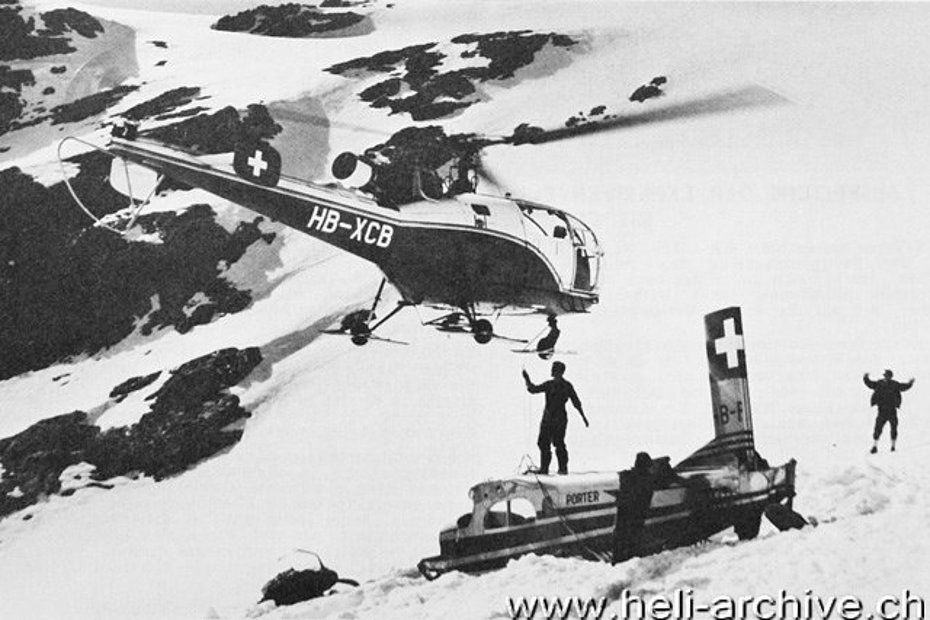
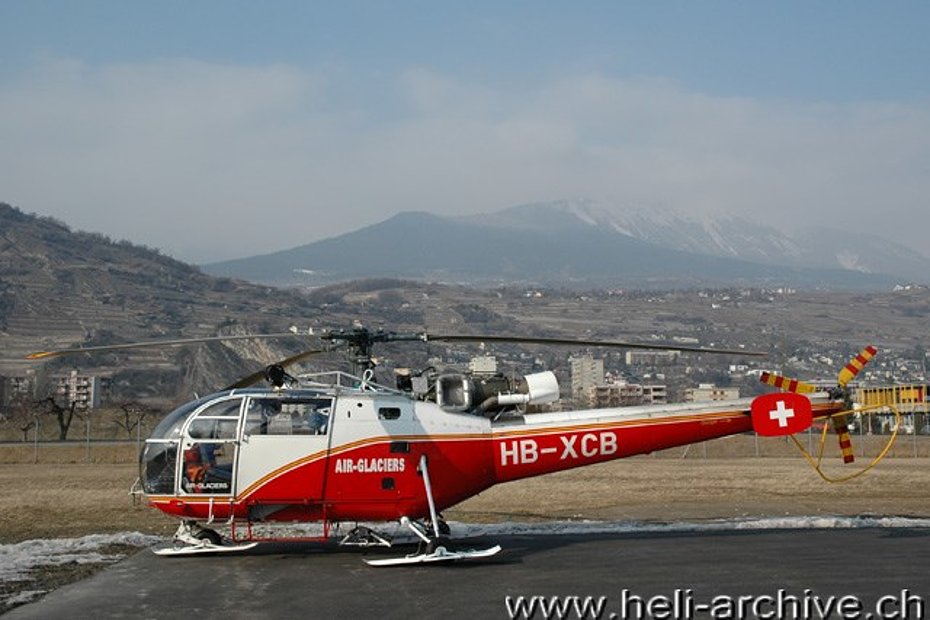
This initial series of tests showed the great versatility of the helicopter and its great power reserve. The Swiss Army, which still had in service the Alouette II, impressed by the qualities of the Alouette III, decided to purchase it. The first one entered service in June 1964. After the delivery of 24 units, the Eidgenössische Flugzeugwerke of Emmen obtained the permission from Aérospatiale to build 60 units under licence.
The military Alouette III were employed by the Swiss Army until the end of 2010 and logged altogether about 300’000 hours of flight.
On the 6th of August 1965 the famous Valaisan pilot Hermann Geiger landed in Sion/VS at the controls of the HB-XCB (s/n 1259 b/y 1965), the first civil Alouette III to be registered in Switzerland. The brand new helicopter arrived from Marignane/F where Geiger attended a special flight course. He was almost certainly the first Swiss civil pilot to obtain the qualification to fly with this model, which was at that time one of the newest in service in this country.
The HB-XCB was purchased by Air Glaciers, a new helicopter company founded on the 1st of August 1965 in Sion.
Since then, Air Glaciers is using it for search and rescue missions as well as for passenger and cargo transportations.
Thanks to its versatility and its excellent high altitude performances the HB-XCB rapidly earned the confidence of the Valaisan pilot Geiger, Martignoni and Bagnoud, Air Glacier’s first helicopter pilots.
Among the first missions of the HB-XCB we should mention the recovery of the Pilatus PC-5 HB-FAP damaged on the 20th of August 1965 on the Audannes/Wildhorn glacier and the rescue flights after the Mattmarks’s tragedy which took place on the 30th of August 1965. In this tragic event an enormous avalanche of snow and ice swept away the life of 88 workers who were building a dam.
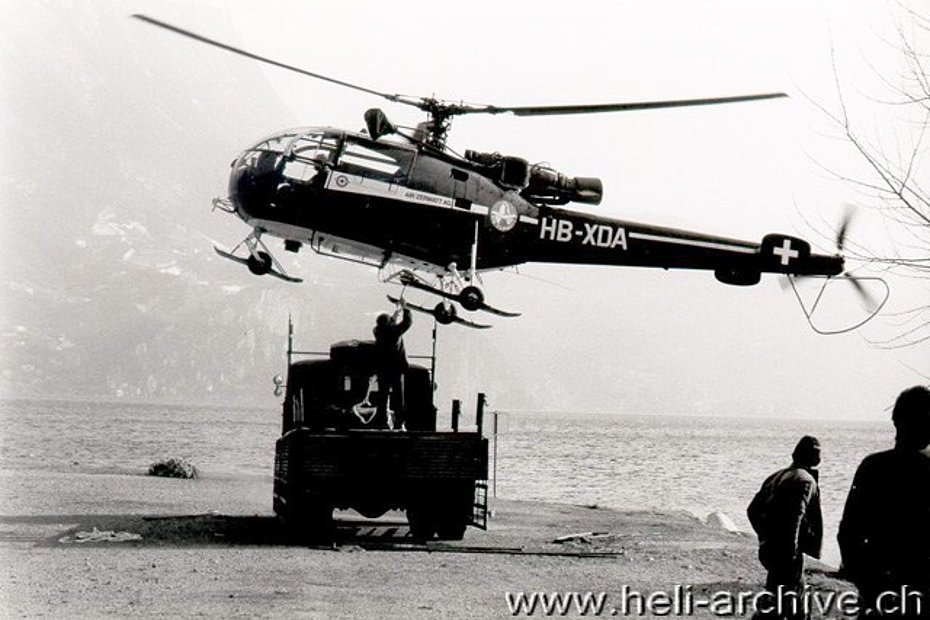
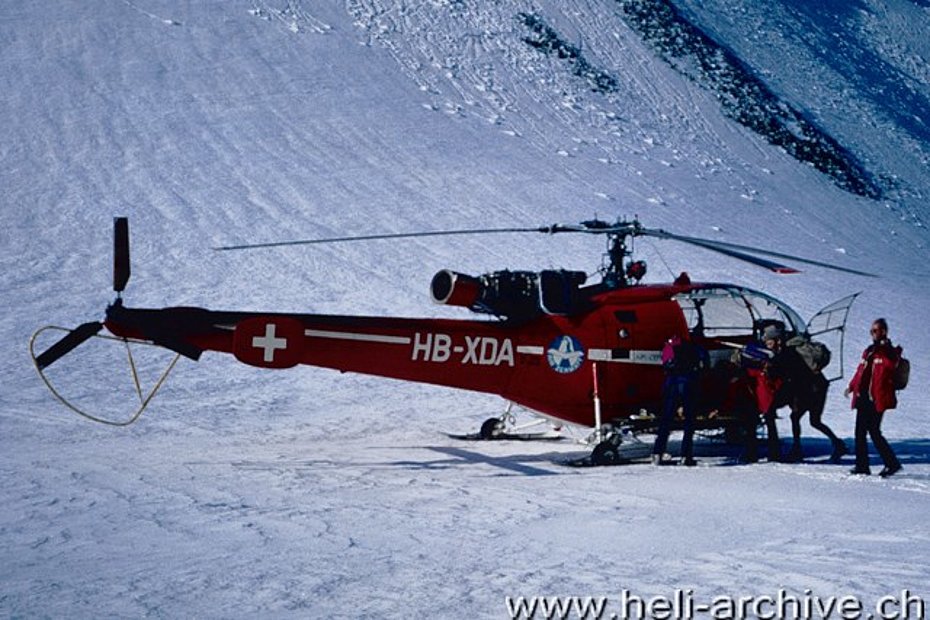
Both of the helicopters mentioned were destroyed in accidents caused by a cable collision, but Air Glacier’s mechanics decided to rebuild them.
In 1969 Air Zermatt purchased the HB-XDA (s/n 1609 b/y 1969) a helicopter which was used a lot in Valais for over 30 years as an aerial ambulance. In the expert hands of pilots like Günther Amann, Sigi Stangier, Markus Burkhard and Toni Lötscher, this helicopter did some of the most extraordinary rescue missions at altitudes exceeding 4’000 meters. It is in fact in the role of “flying Saint Bernard” that this helicopter showed its best qualities and was particularly appreciated by the Swiss pilots.
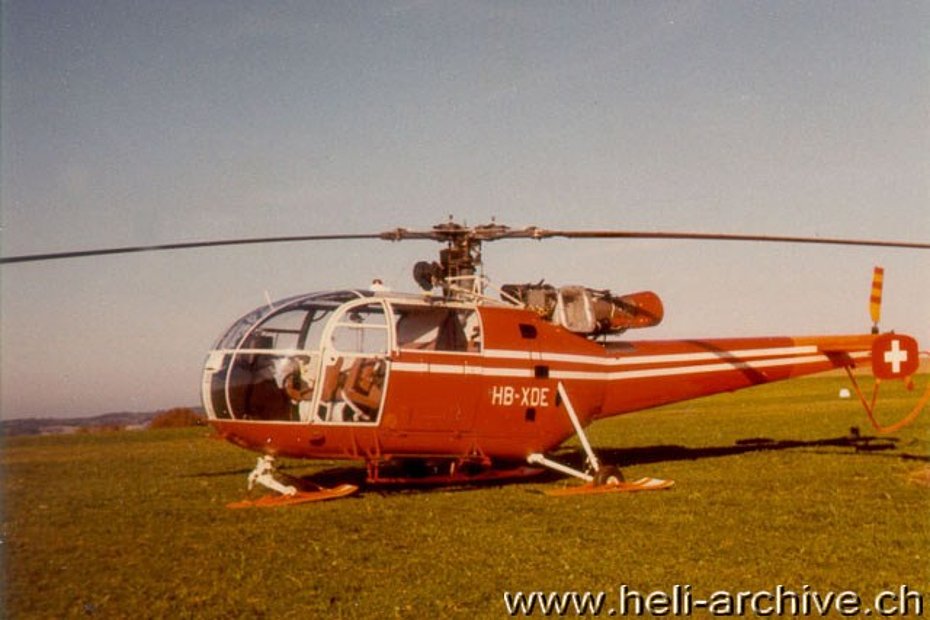
In 1970 the Swiss Confederation decided to purchase the HB-XDE (s/n 1717 b/y 1970) and employ it for the transportation of VIPs, such as the members of the Federal Council and other dignitaries. This helicopter was also used for pilot and instructor courses, the localization of disappeared aircrafts in the Swiss alps, and other tasks of public utility.
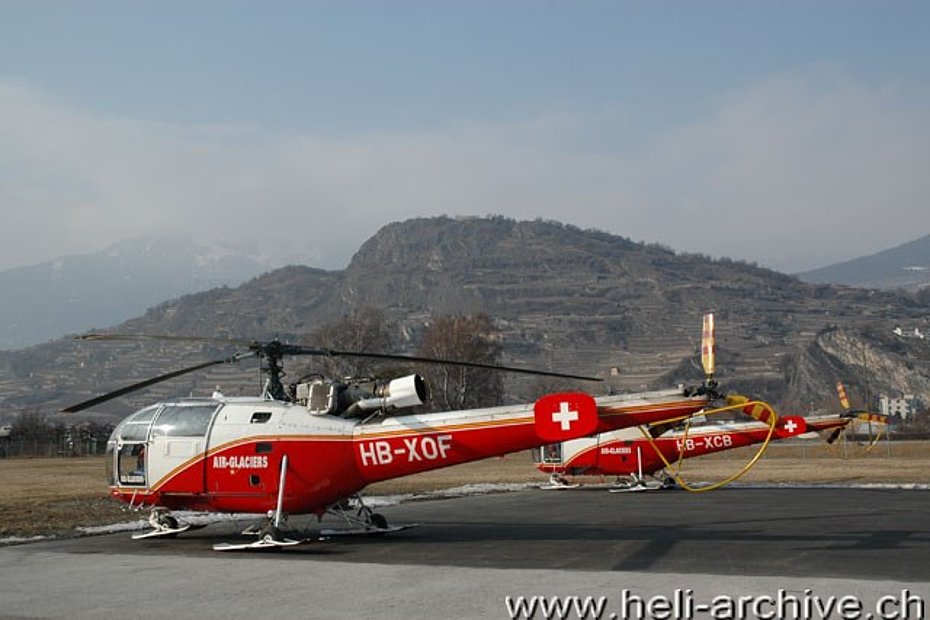
Several other Swiss helicopter companies used the SE 3160 Alouette III and its successors. Among the Alouette’s users to mention the Rega which used the SA 316B and SA 319B. HAB plan to publish a separate focus on this subject.
The success of the Alouette III is confirmed by the fact that today, after more than fifty years from its first flight, it is still actively used. It is a record of longevity which will be absolutely not easy to equal.
Even some Alouette III in service with Air Glaciers could cross the line. In this case we hope that the aerial company based in Sion will commemorate this event adequately, hence… alea iacta est!
Curious news
In 1993 the Denel Aviation company experimentally modified the tail rotor of a Alouette III of the South African Air Force to test a new control system which was christened Cirstel (Combined Infra Red Suppression and Tail rotor Elimination).
Seemingly this control system is similar to that of the Notar developed by the MDD, but it also incorporates a mechanism for the suppression of the exhaust's infrared signature.
Videos on the web
Here is a video from the TSR archives taken in 1966. In the video it is possible to watch the SE 3160 Alouette III HB-XCB while transporting a cross in memory of Hermann Geiger: https://www.rts.ch/archives/tv/information/carrefour/3468230-croix-pour-geiger.html
HAB 03/2011 (updated 01/2014)


